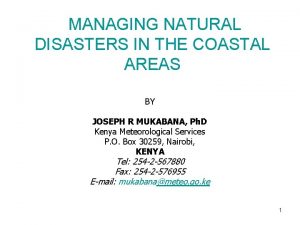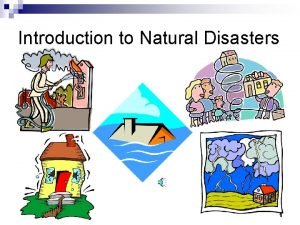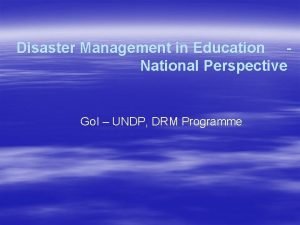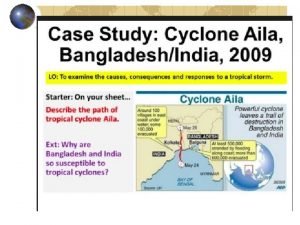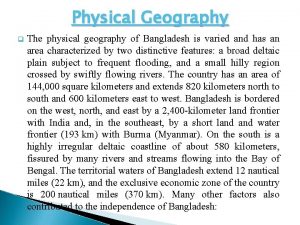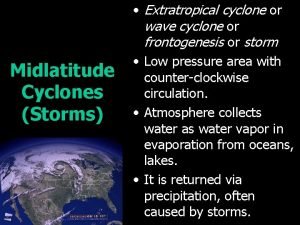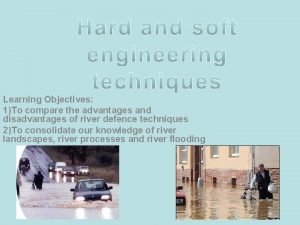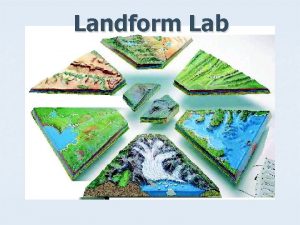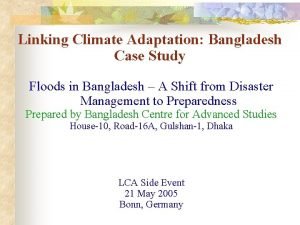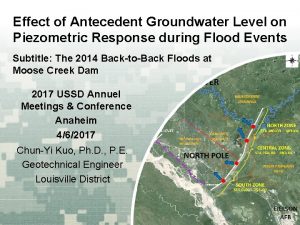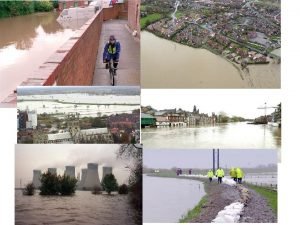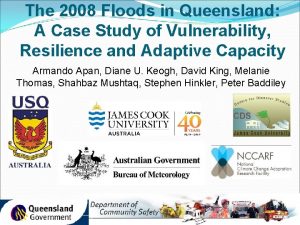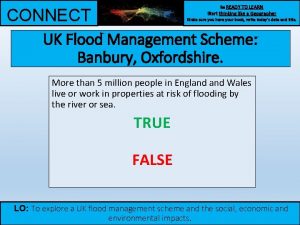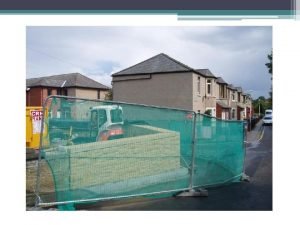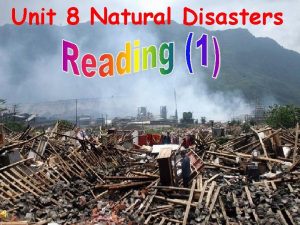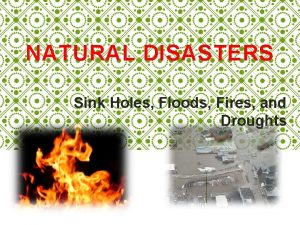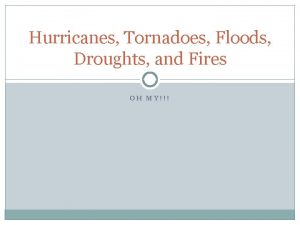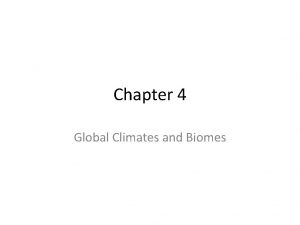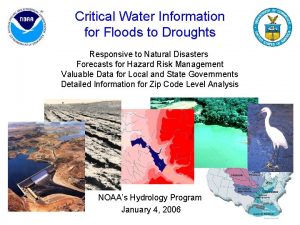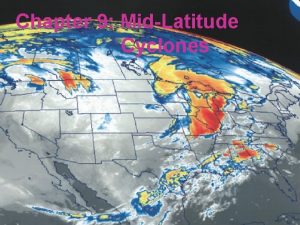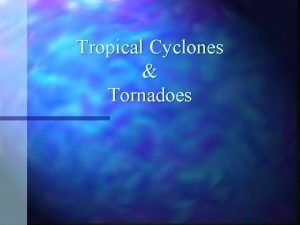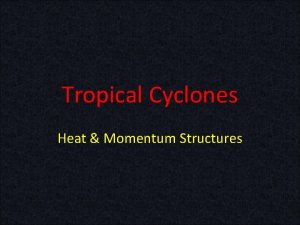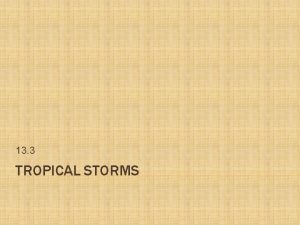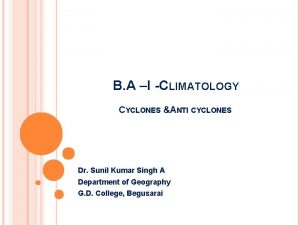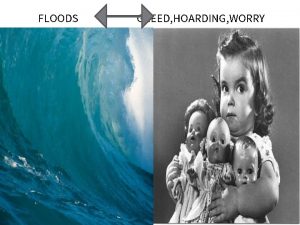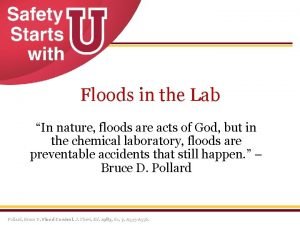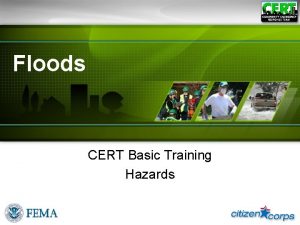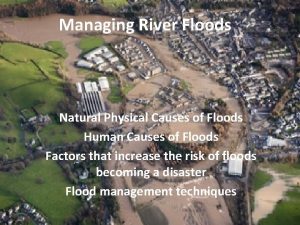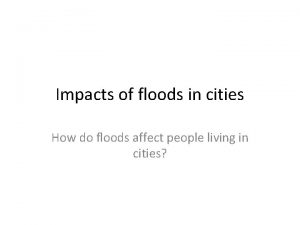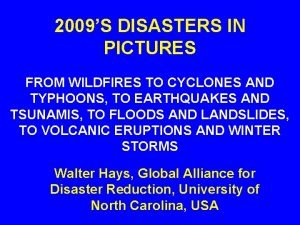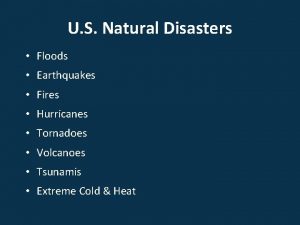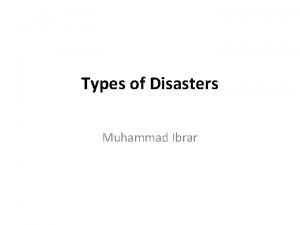PRI INTRODUCTION Disasters like Floods Cyclones Droughts and





















- Slides: 21

PRI

INTRODUCTION • Disasters like Floods, Cyclones, Droughts and Earthquakes are increasing in India due to environmental degradation, deforestation, increasing population, nuclear explosions and air pollutions, etc. There is also worldwide concern to mitigate the growing incidence of disaster and their toll on human life, property and environment. In India floods affect 11. 2 percent of the land drought account for 28 percent of the land, cyclones along 7516 km vulnerable coastline and earthquakes covering 57 percent of the land are other major disasters that occur quite often. Natural Disasters cannot be prevented, but their impact on the lives and the socio-economic aspects of the people can be reduced to a considerable extent.

PRI • The PRI is a statutory body elected by the local people through a well defined democratic process with specific responsibilities and duties. The elected members are accountable to the people of the ward, rural community, block and the district.

• Keeping the above in view, the PRI, the representative body of the people, is the most appropriate institution from village to the district level in view of its proximity, universal coverage and enlisting people‟s participation on an institutionalized basis. Their close involvement will go a long way in getting people prepared for countering natural disasters as well as involve them in all possible preventive and protective activities so that the impact of the disasters are mitigated and the people are able to save their lives and property.

HOW PRI BODIES CAN LEAD • PRE-DISASTER • DURING DISASTER • POST DISASTER

PRE-DISASTER • Organising awareness campaign and promoting community education on disaster preparedness. • Identifying the resource gaps both physical and manpower and replenish the same. • Establishing Cooperation with local agencies including NGOs • Encouraging people to insure assets and livestock. • Activating the DM Plans with the participation of the community. • Formation of Task forces.

DURING DISASTER • Arranging emergency communication through available resources. • Evacuation to temporary shelter and running relief camps. • Safe disposal of carcass and arranging safe drinking water and sanitation.

POST DISASTER • Damage assessment particularly assisting in identifying victims for compensation and its distribution. • Formulating rehabilitation and reconstruction plan of houses and other local infrastructures. • Enforce minimum specification for safe reconstruction.

ROLE OF THE THREE-TIER PRI BODIES IN DISASTER MANAGEMENT • The major role of the Panchayati Raj Bodies in respect of disaster management is in the preparedness planning and its implementation during the impact and post- impact phase as this is the most crucial period for the people facing the disaster. The village people are the most vulnerable for disasters and therefore the Village Panchayats have to play a major role in association with the higher level bodies of PRIs as well as with the Government agencies.

• PHASE – I • • • GRAM PANCHAYATS BLOCK/ PANCHAYAT SAMITIS ZILLA PARISHADS • PHASE – II • • BLOCK/ PANCHAYAT SAMITIS ZILLA PARISHADS • PHASE – III • • • GRAM PANCHAYATS BLOCK/ PANCHAYAT SAMITIS ZILLA PARISHADS

• PHASE – I Tasks to be performed by 3 - tier Panchayat bodies for Preparedness planning

GRAM PANCHAYATS • Convening meetings of ward members to ensure proper information regarding the warning signals reached the people through all media modes. • Selection of location for shifting people/ livestock to safer places • Special arrangements evacuation of handicapped, children and expectant mothers • Stocking food grains, drinking water and other necessities

BLOCK/ PANCHAYAT SAMITIS • Supervise preparedness of the Gram Panchayats • Contacting Ex-army/Security forces personal / volunteers to organize a taskforce to assist people in emergency. • Procure and keep rescue materials including boats ready. • Function as link between the district and village level counter disaster activities.

ZILLA PARISHADS • Before the onset of monsoon (May) and likely periods of cyclone (May- June & Oct-Nov), the District Collector should have a meeting of all District Heads of the Sectoral, Departments and the Members of the Z P for preparedness. • To organize „Task Force‟ at District, Block and the Village levels. • To identify and enlist NGOs who are useful in extending help during disasters. • At the first warning, call the meeting of the Crisis Management Group and alert all concerned at Block and Village levels.

PHASE - II Tasks to be performed by Panchayats for rescue and relief before and during the impact of disasters: 1. With the final warning, operations for the evacuation of people and the livestock should start so that all are at safer places before the disaster strikes. 2. Along with evacuation of people and livestock, storage of food and water for the people and the livestock should be made. 3. The Volunteers and the task forces should be kept in full readiness to take rescue operation at the shortest notice.

BLOCK/ PANCHAYAT SAMITIS • • • With the final warning of cyclone, flood disasters, identify the villages likely to be affected and send teams of Task Forces/ Volunteers to the villages to supervise counter disaster measures. Arrange for emergency communication facility through Police wireless, Radio, etc. Supervise the rescue and relief activities along with District Level officers. Inform the CMG in case specific help for rescue and relief operation is required from the Police and Security forces including Army, Navy and Air Force. Supervise the rescue and relief operations and coordinate with various agencies like Task forces, NGOs and Volunteers engaged in rescue and relief operations.

ZILLA PARISHADS • In the event of on-set of a cyclone /flood disaster monitor the situation, identify the Blocks and villages most likely to be affected and issue warnings at close intervals to all concerned. • Activate control room and keep full watch on the situations. • Activate CMG and put them on job for assisting Block and Village Panchayats for taking counter disaster measures. • Arrange for temporary emergency shelters/ relief camps and supply and transport of all essential food and non- food items to relief camp. • Monitoring of the rescue and relief operations at the village level. • Assisting the Block and village Panchayats in mobilising task forces/ Volunteers/ NGOs for rescue and relief operations. • Maintain minute to minute information on the situation during and immediately after the impact and keep ready to meet any specific emergency.

PHASE – III • Reconstruction and long term planning:

GRAM PANCHAYATS • Assist in the identification of the victims of the disaster and eligible for various types of compensations and assist in the distribution. • Help district and block level organizations in organizing awareness camps for management and mitigation of disasters and ensure the participation of the villagers. • Organize village level Task Force/ Volunteers and train them in counter disaster measures. • Assist block and district level agencies in all activities related to disaster management and mitigation. • Assist block and district level agencies in the supervision and the monitoring of the reconstruction and development projects within the village.

BLOCK/ PANCHAYAT SAMITIS • Assist in Planning and Implementation of Rehabilitation of affected people; Repair and reconstruction of damaged house, physical infrastructure etc. and return to normal economic activities including farming etc. • Based on hazard and vulnerability prepare village and block level mitigation plan and consolidate and integrate into block plan. • Assist and execute repair and reconstruction activities. • Assist for enforcing the specified code or specification for the construction of houses and buildings, roads and other physical infrastructure. • Assist in the formulation of long term mitigation planning and its integration with the development plan of the block and the district.

ZILLA PARISHADS • Planning and Implementation of Rehabilitation of affected people, repair and reconstruction of damaged houses, physical infrastructure, etc and return to normal economic activities including farming etc. • Compensation for loss of lives, properties of individuals should also begin. • Supervise all construction and development activities.
 Climate change causing droughts
Climate change causing droughts Natural disasters introduction
Natural disasters introduction Introduction of natural disaster
Introduction of natural disaster Man-made disasters introduction
Man-made disasters introduction Distribution of tropical storms
Distribution of tropical storms What are middle latitude cyclones
What are middle latitude cyclones Physiography of bangladesh
Physiography of bangladesh Wave cyclone
Wave cyclone Mt air mass
Mt air mass Disadvantages of floodplain
Disadvantages of floodplain Mr. flood's party poem analysis
Mr. flood's party poem analysis Ladysmith floods 1994
Ladysmith floods 1994 Is barrier islands constructive or destructive
Is barrier islands constructive or destructive Bangladesh floods case study
Bangladesh floods case study Conclusion on flood
Conclusion on flood York floods 2000
York floods 2000 2008 floods mackay
2008 floods mackay Banbury floods 1998
Banbury floods 1998 Morpeth floods 2008
Morpeth floods 2008 Emergency care first aid and disasters
Emergency care first aid and disasters Unit 8 natural disasters
Unit 8 natural disasters Natural disasters listening comprehension
Natural disasters listening comprehension

